A Survey of the Relationship between Climatic Heat Stress Indices and Fundamental Milk Components Considering Uncertainty
Abstract
:1. Introduction
| Year | Indices | Abbr. of Indices | Author(s) |
|---|---|---|---|
| 2001, 2003 | Environmental Stress Index | ESI | Moran et al. [14,15] |
| 2002 | Heat Load Index | HLI | Gaughan et al. [16] |
| 2003 | Respiratory Rate Index | RR or RRP | Eigenberg et al. [17] |
| 2008 | Heat Load Index (modified) | HLI | Gaughan et al. [18] |
2. Materials and Methods
2.1. Geography of the Study Domain
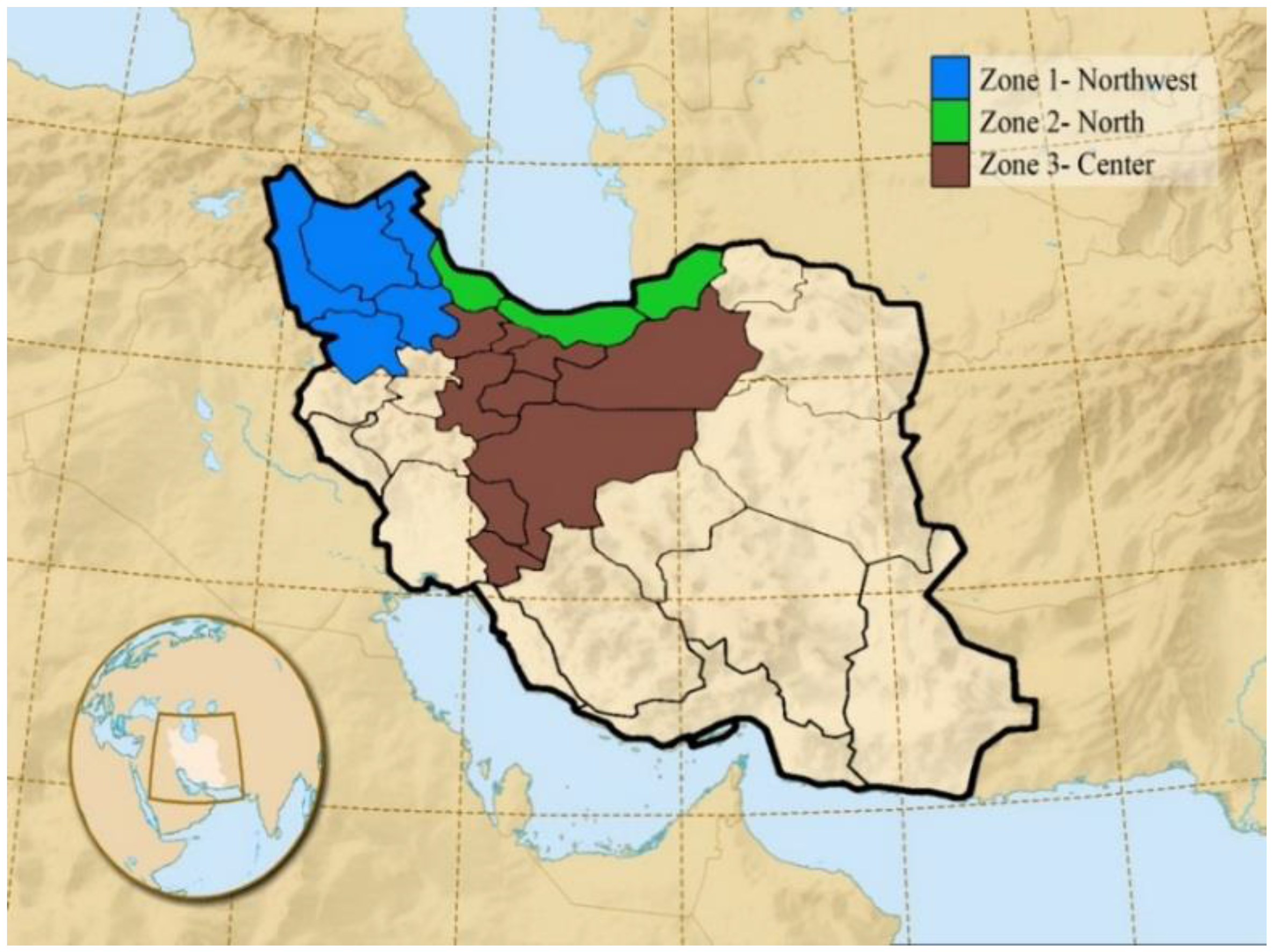
2.2. Observed and Reanalysis Data and Calculated Climate Indices
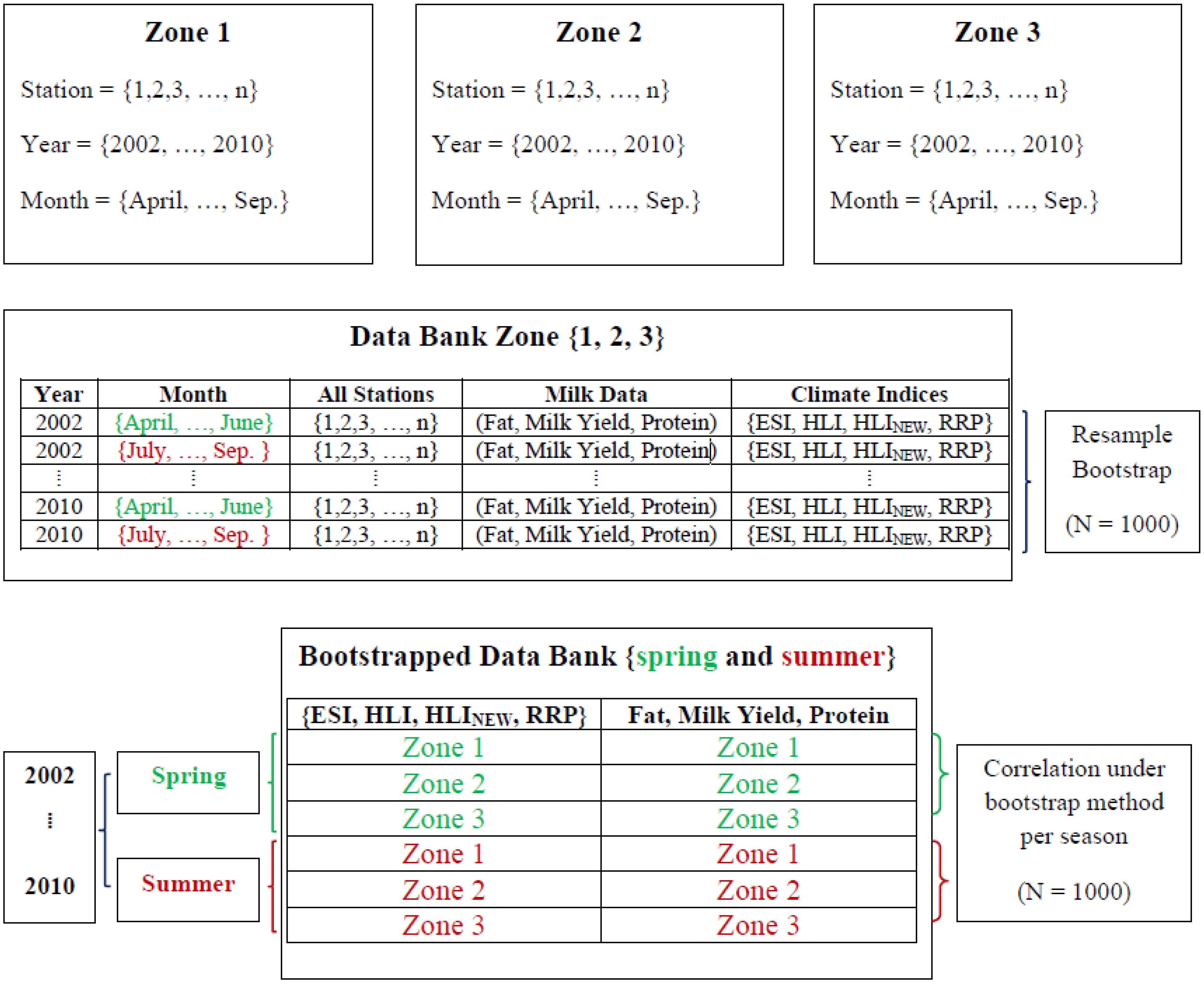
2.2.1. Environmental Stress Index (ESI)
2.2.2. Heat Load Index (HLI)
2.2.3 Respiratory Rate Predictor Index (RRP)
2.3. Uncertainty Consideration by Applying the Bootstrap Technique
2.4. Linear Regression Analysis between Climatic Indices and Milk Compounds with Bootstrapping
3. Results and Discussion
3.1. Climatic Index and Milk Parameter Statistics
| Fat (g/100 mL) | Protein (gr/100 mL) | Milk Yield (kg) | ||||
|---|---|---|---|---|---|---|
| Spring | Summer | Spring | Summer | Spring | Summer | |
| 2002 | 3.14 | 3.13 | 2.92 | 2.83 | 26.16 | 25.61 |
| 2003 | 3.22 | 3.11 | 2.87 | 2.87 | 25.93 | 25.59 |
| 2004 | 3.14 | 3.07 | 2.89 | 2.91 | 25.04 | 23.8 |
| 2005 | 3.15 | 3.12 | 2.83 | 3.06 | 25.92 | 24.8 |
| 2006 | 3.15 | 3.13 | 2.96 | 2.98 | 26.78 | 25.33 |
| 2007 | 3.19 | 3.17 | 2.95 | 2.95 | 26.73 | 25.75 |
| 2008 | 3.19 | 3.18 | 3.05 | 3.04 | 27.23 | 25.98 |
| 2009 | 3.33 | 3.18 | 3.05 | 3.05 | 27.44 | 26.1 |
| 2010 | 3.34 | 3.27 | 3.03 | 2.95 | 26.64 | 26.26 |
| Spring | Summer | ||||||||
|---|---|---|---|---|---|---|---|---|---|
| ESI | HLI | HLI New | RRP | ESI | HLI | HLI New | RRP | ||
| Minimum | 8.44 | 68.07 | 56.01 | –36.19 | 13.40 | 77.18 | 68.17 | 6.64 | |
| Median | 13.86 | 78.22 | 69.46 | 10.82 | 16.83 | 83.50 | 75.94 | 36.2 | |
| Average | 13.32 | 76.87 | 67.62 | 5.85 | 16.33 | 82.68 | 75.07 | 31.88 | |
| Maximum | 17.60 | 84.43 | 77.03 | 42.37 | 18.07 | 86.30 | 79.63 | 47.1 | |
| NDS | ---- | 113 | 11 | 0 | --- | 247 | 102 | 0 | |
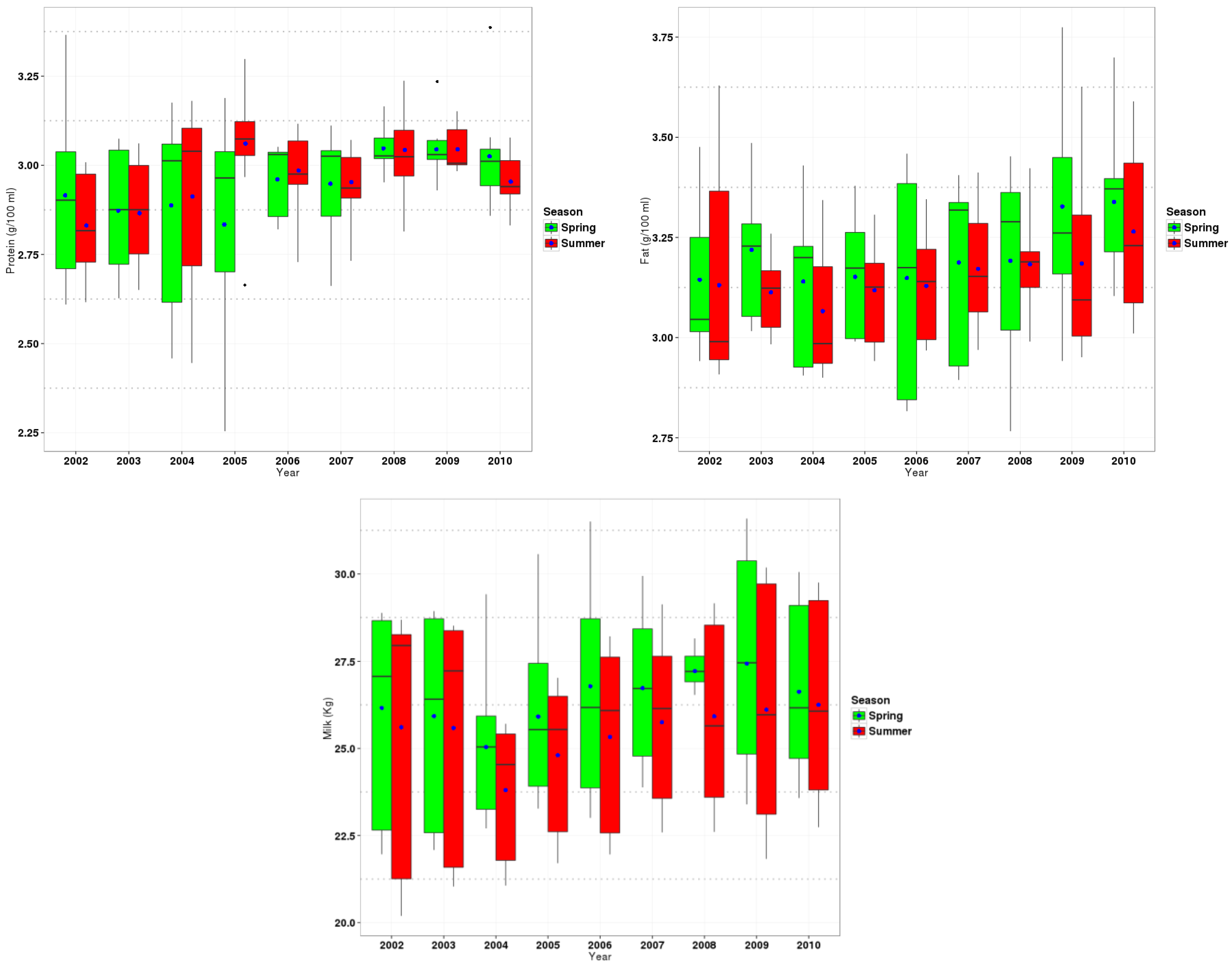

3.2. Correlation between the Climatic Indices and Milk Parameters
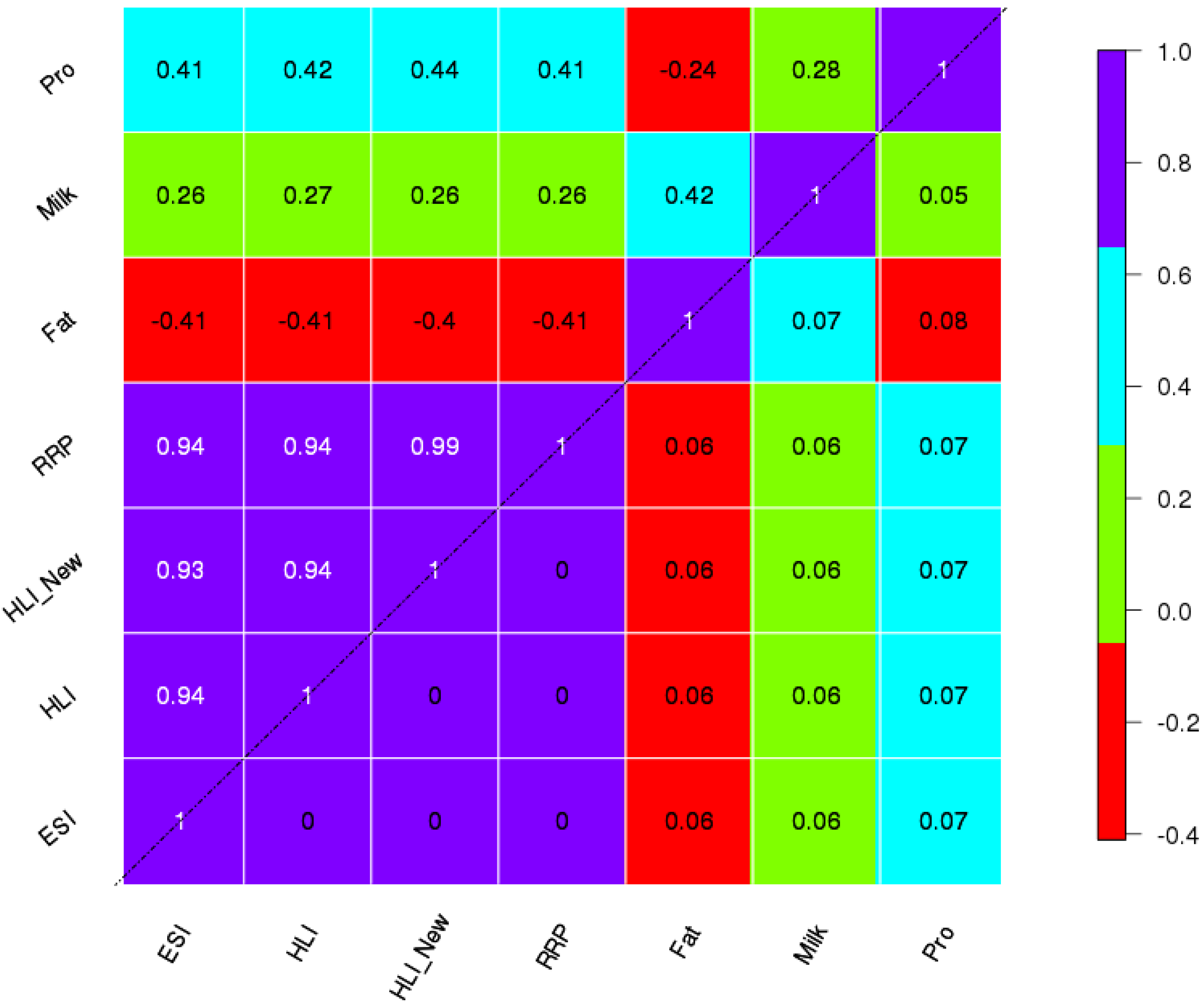


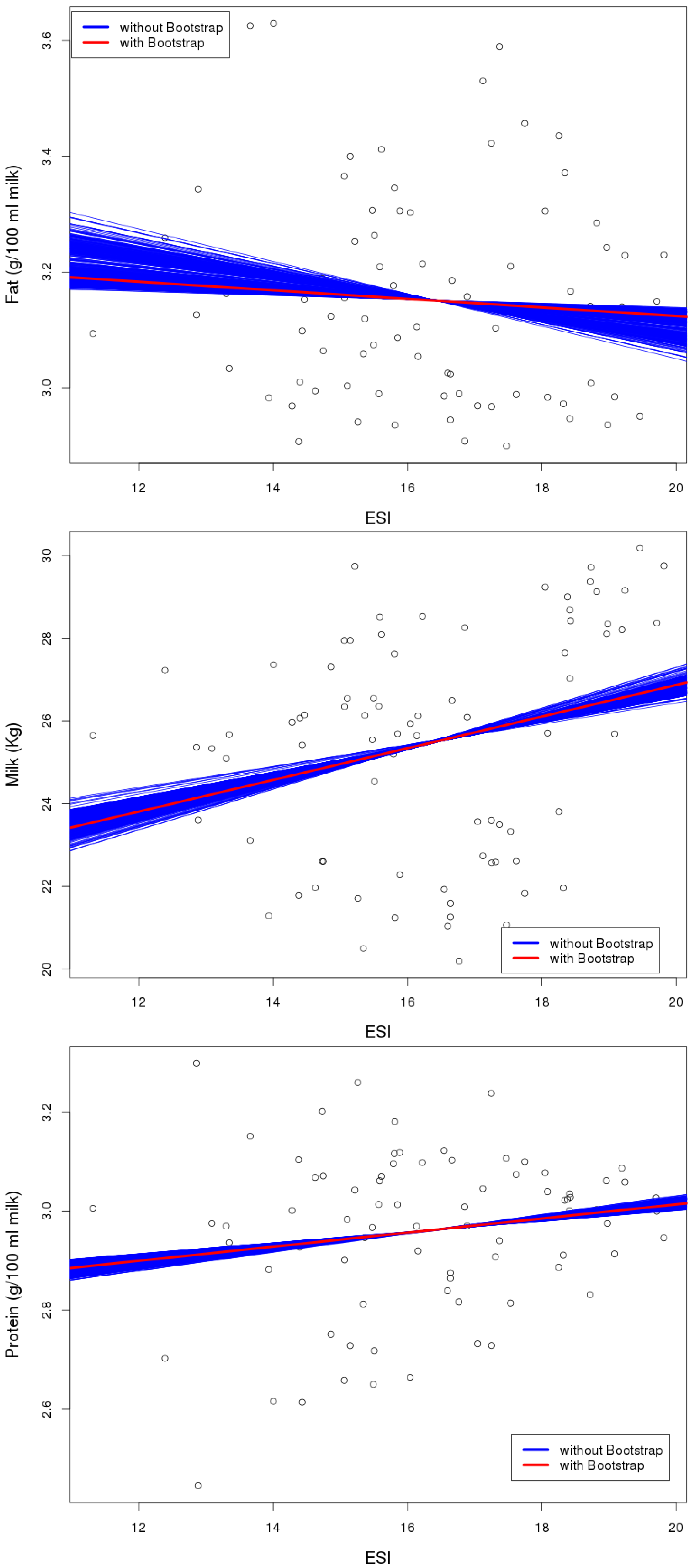
4. Conclusions
Acknowledgments
Author Contributions
Conflicts of Interest
Appendix

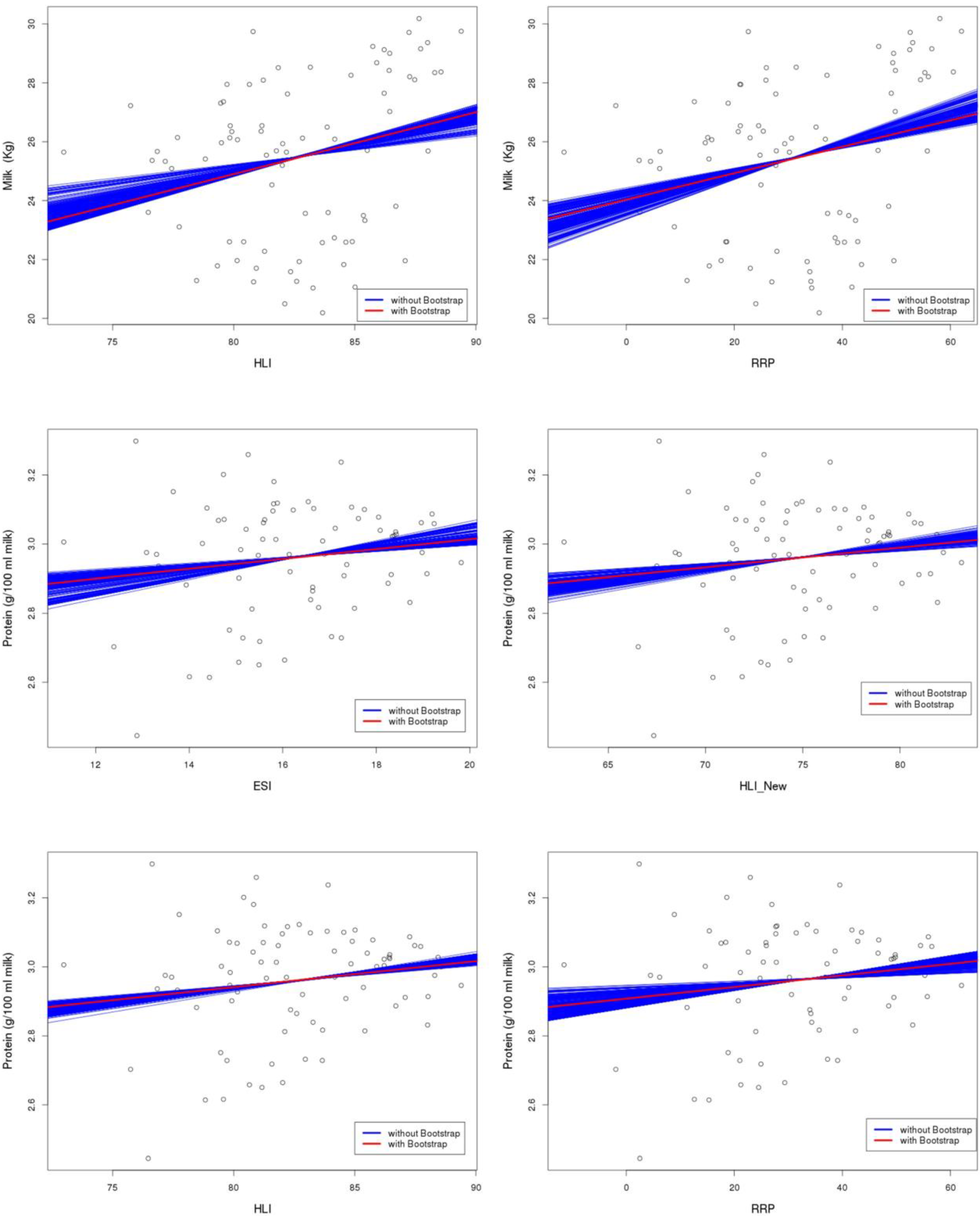
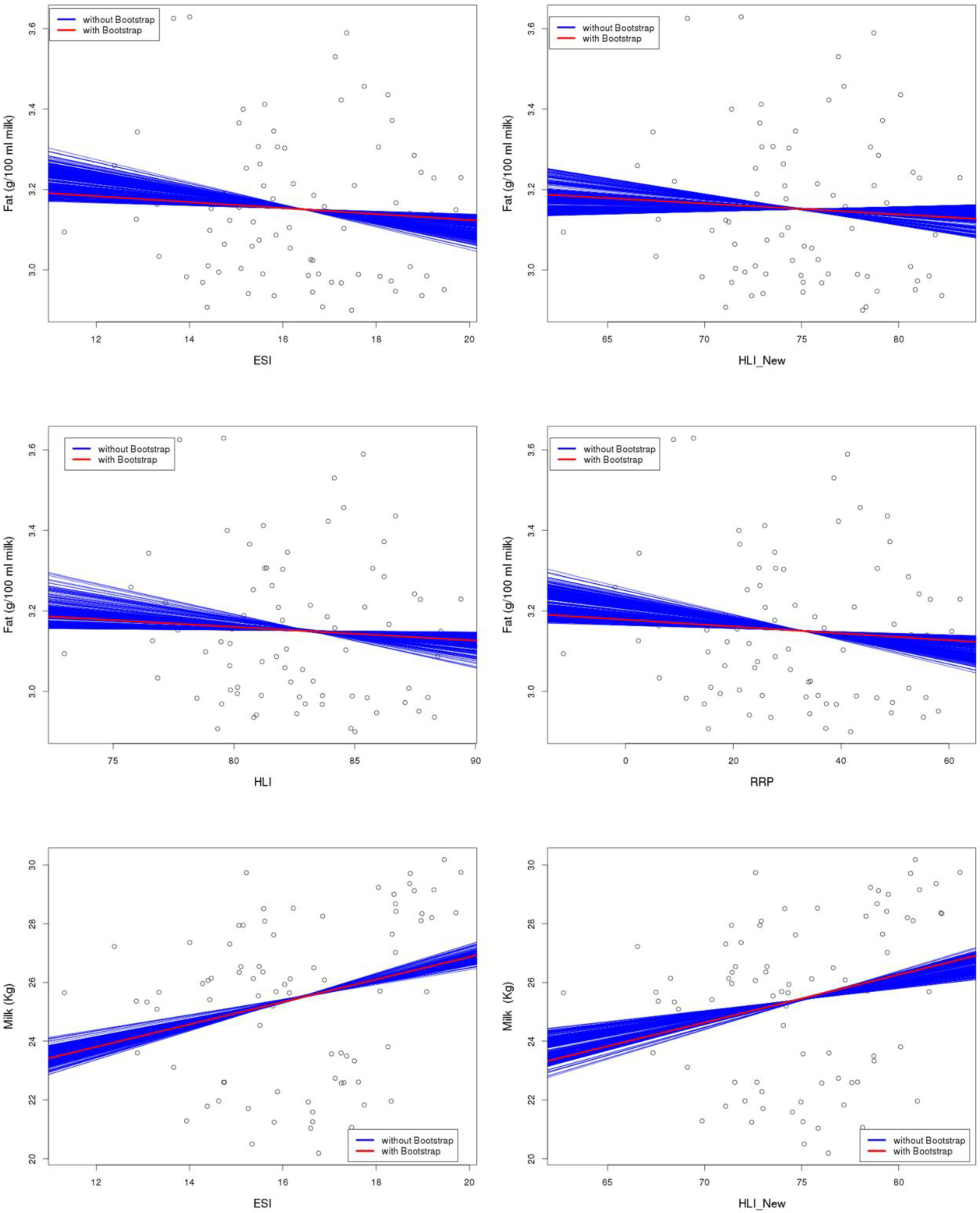
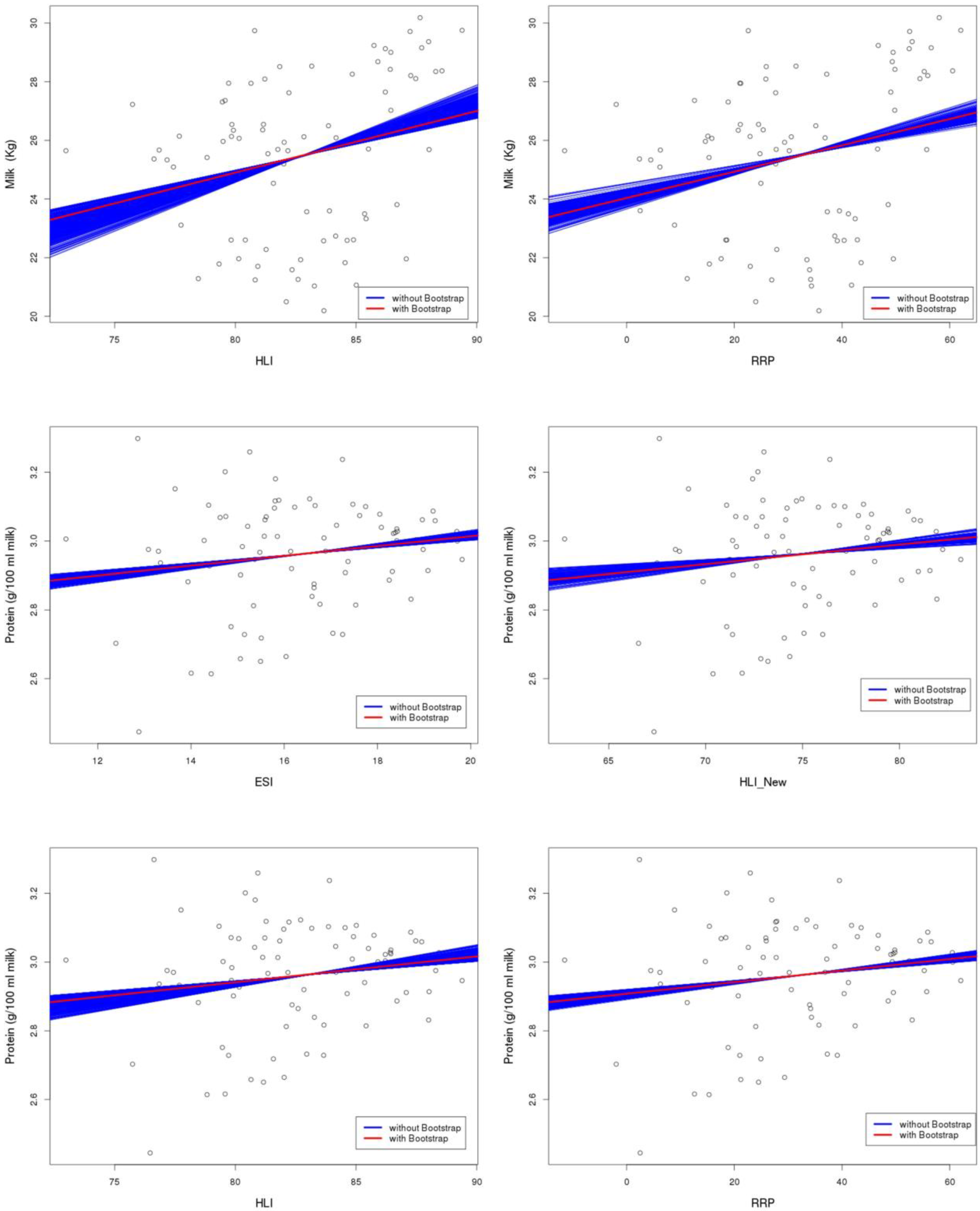
References
- Watson, R.T.; Albritton, D.L.; Barker, T.; Bashmakov, I.A.; Canziani, O.; Christ, R.; Cubasch, U.; Davidson, O.; Gitay, H.; Griggs, D.; et al. Climate Chance 2001: IPCC Synthesis Report. Avalable oneline: http://ipcc.ch/meetings/session18/doc3b.pdf (accessed on 5 March 2015).
- Renaudeau, D.; Collin, A.; Yahav, S.; De Basilio, V.; Gourdine, J.L.; Collier, R.J. Adaptation to hot climate and strategies to alleviate heat stress in livestock production. Animal 2012, 6, 707–728. [Google Scholar] [CrossRef] [PubMed]
- Lambertz, C.; Sanker, C.; Gauly, M. Climatic effects on milk production traits and somatic cell score in lactating Holstein-Friesian cows in different housing systems. J. Dairy Sci. 2014, 97, 319–329. [Google Scholar] [CrossRef] [PubMed]
- Sharma, A.K.; Rodriguez, L.A.; Mekonnen, G.; Wilcox, C.J.; Bachman, K.C.; Collier, R.J. Climatological and genetic effects on milk composition and yield. J. Dairy Sci. 1983, 66, 119–126. [Google Scholar] [CrossRef]
- Marami Milani, M.R.; Hense, A.; Rahmani, E.; Ploeger, A. A pilot investigation of the relationship between climate variability and milk compounds under the bootstrap technique. Foods 2015, 4, 420–439. [Google Scholar] [CrossRef]
- Silva, R.G.; Morais, D.A.; Guilhermino, M.M. Evaluation of thermal stress indexes for dairy cows in tropical regions. R. Bras. Zootec. 2007, 36, 1192–1198. [Google Scholar] [CrossRef]
- Eigenberg, R.A.; Hahn, G.L.; Nienaber, J.A.; Brown-Brandl, T.M. Development of a new respiration rate monitor for cattle. Trans. ASAE 2000, 43, 723–728. [Google Scholar] [CrossRef]
- Hahn, G.L.; Mader, T.L. Heat waves in relation to thermoregulation, feeding behavior and mortality of feedlot cattle. In Proceedings of the 5th International Livestock Environment Symposium, Bloomington, MN, USA, 29–31 May 1997; pp. 545–549.
- Ingram, D.L.; Mount, L.E. Heat exchange between animal and environment. In Man and Animals in Hot Environments; Springer: New York, NY, USA, 1975; pp. 5–23. [Google Scholar]
- Mader, T.L.; Dahlquist, J.M.; Hahn, G.L.; Gaughan, J.B. Shade and wind barrier effects on summertime feedlot cattle performance. J. Anim. Sci. 1999, 77, 2065–2072. [Google Scholar] [PubMed]
- McLean, J.A. Loss of heat by evaporation. In Heat Loss from Animals and Man: Assessment and Control; Monteith, J.L., Mount, L.E., Eds.; Butterworth-Heinemann: London, UK, 1974; pp. 19–31. [Google Scholar]
- Spain, J.N.; Spiers, D.E. Effects of supplemental shade on thermoregulatory response of calves to heat challenge in a hutch environment. J. Dairy Sci. 1996, 79, 639–646. [Google Scholar] [CrossRef]
- Mader, T.L.; Davis, M.S. Wind speed and solar radiation corrections for the temperature-humidity index. In Proceedings of the 15th Conference on Biometeorology and Aerobiology Joint with 16th International Congress on Biometeorology, Kansas City, MO, USA, 27 October 2002; pp. 10–28.
- Moran, D.S.; Pandolf, K.B.; Shapiro, Y.; Heled, Y.; Shani, Y.; Matthew, W.T.; Gonzales, R.R. An environmental stress index (ESI) as a substitute for the wet bulb globe temperature (WBGT). J. Therm. Biol. 2001, 26, 427–431. [Google Scholar] [CrossRef]
- Moran, D.S.; Pandolf, K.B.; Shapiro, Y.; Laor, A.; Heled, Y.; Gonzalez, R.R. Evaluation of the environmental stress index for physiological variables. J. Therm. Biol. 2003, 28, 43–49. [Google Scholar] [CrossRef]
- Gaughan, J.G.; Goopy, L.; Spark, J. Excessive Heat Load Index for Feedlot Cattle; Meat and Livestock Australia: Sydney, NSW, Australia, 2002. [Google Scholar]
- Eigenberg, R.A.; Nienaber, J.A.; Brown-Brandl, T.M. Development of a livestock safety monitor for cattle. In Proceedings of the 2003 American Society of Agricultural and Biological Engineers (ASABE) Annual Meeting, St. Joseph, MI, USA, 27–30 July 2003.
- Gaughan, J.G.; Mader, T.L.; Holt, S.M.; Lisle, A. A new heat load index for feedlot cattle. J. Anim. Sci. 2008, 86, 226–234. [Google Scholar] [CrossRef] [PubMed]
- Rienecker, M.M.; Suarez, M.J.; Gelaro, R.; Todling, R.; Bacmeister, J.; Liu, E.; Bosilovich, M.G.; Schubert, S.D.; Takacs, L.; Kim, G.K.; et al. MERRA: NASA’s Modern-Era retrospective analysis for research and applications. J. Climate 2011, 24, 3624–3648. [Google Scholar] [CrossRef]
- Maak, K.; von Storch, H. Statistical downscaling of monthly mean air temperature to the beginning of flowering of Galanthus nivalis L. in Northern Germany. Int. J. Biometeorol. 1997, 41, 5–12. [Google Scholar] [CrossRef]
- Matulla, C.; Scheifinger, H.; Menzel, A.; Koch, E. Exploring two methods for statistical downscaling of Central European phenological time series. Int. J. Biometeorol. 2003, 48, 56–64. [Google Scholar] [CrossRef] [PubMed]
- Lahiri, S.N. Bootstrap methods. In Resampling Methods for Dependent Data; Springer: New York, NY, USA, 2003; pp. 17–43. [Google Scholar]
- Politis, D.N.; Romano, J.P.; Wolf, M. Subsampling; Springer: New York, NY, USA, 1999. [Google Scholar]
- Lunneborg, C.E. Estimating the correlation coefficient: The bootstrap approach. Psychol. Bull. 1985, 98, 209–215. [Google Scholar] [CrossRef]
- Rasmussen, J.L. Estimating correlation coefficients: Bootstrap and parametric approaches. Psychol. Bull. 1987, 101, 136–139. [Google Scholar] [CrossRef]
- Jhun, M.; Jeong, H.C. Applications of bootstrap methods for categorical data analysis. Comput. Stat. Data Anal. 2000, 35, 83–91. [Google Scholar] [CrossRef]
- Rahmani, E. The Effect of Climate Variability on Wheat in Iran. Ph.D. Thesis, University of Bonn, Bonn, Germany, 2015. [Google Scholar]
- Rahmani, E.; Friederichs, P.; Keller, J.; Hense, A. Development of an effective and potentially scalable weather generator for temperature and growing degree days. Theor. Appl. Climatol. 2015. [Google Scholar] [CrossRef]
- Kousari, M.R.; Ahani, H.; Hendi-Zadeh, R. Temporal and spatial trend detection of maximum air temperature in Iran during 1960–2005. Glob. Planet. Change 2013, 111, 97–110. [Google Scholar] [CrossRef]
- Statistical Center of Iran / History. Available online: http://www.amar.org.ir/Default.aspx?tabid=281 (accessed on 05 August 2014).
- Lescourret, F.; Coulon, J.B. Modeling the impact of mastitis on milk production by dairy cows. J. Dairy Sci. 1994, 77, 2289–2301. [Google Scholar] [CrossRef]
- West, J.W. Effects of heat-stress on production in dairy cattle. J. Dairy Sci. 2003, 86, 2131–2144. [Google Scholar] [CrossRef]
- R Development Core Team. R: A Language and Environment for Statistical Computing; R Foundation for Statistical Computing: Vienna, Austria, 2011. [Google Scholar]
- Epstein, Y.; Moran, D.S. Thermal comfort and the heat stress indices. Ind. Health 2006, 44, 388–398. [Google Scholar] [CrossRef] [PubMed]
- Moran, D.S.; Epstein, Y. Evaluation of the environmental stress index (ESI) for hot/dry and hot/wet climates. Ind. Health 2006, 3, 399–403. [Google Scholar] [CrossRef]
- Kraus, H. Die Luftfeuchtigkeit. In Die Atmosphäre der Erde, 3rd ed.; Springer: Berlin, Germany, 2004; pp. 67–89. [Google Scholar]
- Efron, B.; Tibshirani, R. Bootstrap methods for standard errors, confidence intervals, and other measures of statistical accuracy. J. Statist. Sci. 1986, 1, 54–75. [Google Scholar] [CrossRef]
- Davison, A.C.; Hinkley, D.V. Bootstrap Methods and Their Application; Cambridge University Press: New York, NY, USA, 1997. [Google Scholar]
- Press, W.H.; Teukolsky, S.A.; Vetterling, W.T.; Flannery, B.P. Numerical Recipes: The Art of Scientific Computing, 3rd ed.; Cambridge University Press: Cambridge, UK, 2007. [Google Scholar]
- Knapp, D.M.; Grummer, R.R. Response of lactating dairy cows to fat supplementation during heat stress. J. Dairy Sci. 1991, 74, 2573–2579. [Google Scholar] [CrossRef]
- Roman-Ponce, H.; Thatcher, W.W.; Buffington, D.E.; Wilcox, C.J.; Van Horn, H.H. Physiological and production responses of dairy cattle to a shade structure in a subtropical environment. J. Dairy Sci. 1977, 60, 424–430. [Google Scholar] [CrossRef]
- Rodriquez, L.A. Effects of relative humidity, maximum and minimum temperature, pregnancy, and stage of lactation on milk composition and yield. J. Dairy Sci. 1985, 68, 973–978. [Google Scholar] [CrossRef]
- Bouraoui, R.; Lahmarb, M.; Majdoubc, A.; Djemalic, M.; Belyead, R. The relationship of temperature-humidity index with milk production of dairy cows in a Mediterranean climate. J. Anim. Res. 2002, 51, 479–491. [Google Scholar] [CrossRef]
- Silva, R.G.; Campos Maia, A.S. Thermal stress indexes. In Principles of Animal Biometeorology; Springer: Dordrecht, Netherlands, 2013; pp. 207–229. [Google Scholar]
- Friendly, M. Corrgrams: Exploratory displays for correlation matrices. Am. Stat. 2002, 56, 316–324. [Google Scholar] [CrossRef]
- Hammami, H.; Vandenplas, J.; Vanrobays, M.L.; Rekik, B.; Bastin, C.; Gengler, N. Genetic analysis of heat stress effects on yield traits, udder health, and fatty acids of Walloon Holstein cows. J. Dairy Sci. 2015, 98, 4956–4968. [Google Scholar] [CrossRef] [PubMed]
- Beatty, D.T.; Barnes, A.; Taylor, E.; Pethick, D.; McCarthy, M.; Maloney, S.K. Physiological responses of Bostaurus and Bosindicus cattle to prolonged continuous heat and humidity. J. Animal Sci. 2006, 84, 972–985. [Google Scholar]
- Ciais, Ph.; Reichstein, M.; Viovy, N.; Granier, A.; Ogée, J.; Allard, V.; Aubinet, M.; Buchmann, N.; Bernhofer, Chr.; Carrara, A.; et al. Europe-wide reduction in primary productivity caused by the heat and drought in 2003. J. Nature 2005, 437, 529–533. [Google Scholar] [CrossRef] [PubMed]
- Collier, R.J.; Dahl, E.; VanBaale, M.J. Major advances associated with environmental effects on dairy cattle. J. Dairy Sci. 2006, 89, 1244–1253. [Google Scholar] [CrossRef]
- Gauly, M.; Bollwein, H.; Breves, G.; Brugemann, K.; Danicke, S.; Das, G.; Demeler, J.; Hansen, H.; Isselstein, J.; Konig, S.; et al. Future consequences and challenges for dairy cow production system arising from climate change in center Europe—A review. Animal 2013, 7, 843–859. [Google Scholar] [CrossRef] [PubMed]
- Myneni, R.B.; Keeling, C.D.; Tucker, C.J.; Asrar, G.; Nemani, R.R. Increased plant growth in the northern high latitudes from 1981 to 1991. Nature 1997, 386, 698–702. [Google Scholar] [CrossRef]
- Nikkhah, A.; Furedi, C.J.; Kennedy, A.D.; Scott, S.L.; Wittenberg, K.M.; Crow, G.H.; Plaizier, J.C. Morning v.s. evening feed delivery for lactating dairy cows. Can. J. Anim. Sci. 2011, 91, 113–122. [Google Scholar] [CrossRef]
- O’Brien, M.D. Metabolic adaptations to heat stress in growing cattle. Domest. Anim. Endocrinol. 2010, 38, 86–94. [Google Scholar] [CrossRef] [PubMed]
- Brown-Brandl, T.M.; Eigenberg, R.A.; Nienaber, J.A.; Hahn, G.L. Dynamic response indicators of heat stress in shaded and non-shaded feedlot cattle, Part 1: Analyses of indicators. Biosyst. Eng. 2005, 90, 451–462. [Google Scholar] [CrossRef]
- Udo, H.J.M. Hair Coat Characteristics in Friesian Heifers in the Netherlands and Kenya: Experimental Data and A Review of Literature. Ph.D. Thesis, University of Wageningen, Wageningen, The Netherlands, 1978. [Google Scholar]
© 2015 by the authors; licensee MDPI, Basel, Switzerland. This article is an open access article distributed under the terms and conditions of the Creative Commons Attribution license (http://creativecommons.org/licenses/by/4.0/).
Share and Cite
Milani, M.R.M.; Hense, A.; Rahmani, E.; Ploeger, A. A Survey of the Relationship between Climatic Heat Stress Indices and Fundamental Milk Components Considering Uncertainty. Climate 2015, 3, 876-900. https://doi.org/10.3390/cli3040876
Milani MRM, Hense A, Rahmani E, Ploeger A. A Survey of the Relationship between Climatic Heat Stress Indices and Fundamental Milk Components Considering Uncertainty. Climate. 2015; 3(4):876-900. https://doi.org/10.3390/cli3040876
Chicago/Turabian StyleMilani, Mohammad Reza Marami, Andreas Hense, Elham Rahmani, and Angelika Ploeger. 2015. "A Survey of the Relationship between Climatic Heat Stress Indices and Fundamental Milk Components Considering Uncertainty" Climate 3, no. 4: 876-900. https://doi.org/10.3390/cli3040876
APA StyleMilani, M. R. M., Hense, A., Rahmani, E., & Ploeger, A. (2015). A Survey of the Relationship between Climatic Heat Stress Indices and Fundamental Milk Components Considering Uncertainty. Climate, 3(4), 876-900. https://doi.org/10.3390/cli3040876





